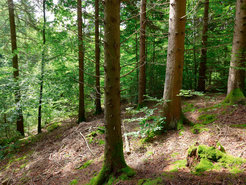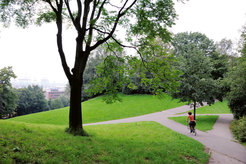Pleasant Green or Deep Dark Woods: Do Forests (Still) Evoke Fear in Us?
Center for the History of Emotions & Lise Meitner Group for Environmental Neuroscience
Forests and natural environments are increasingly valued for their curative and therapeutic effects on humans. However, the forest has historically also been associated with negative emotions such as fear. This interdisciplinary study brings together researchers in environmental neuroscience and in the history of emotions to jointly investigate forest anxiety today.

Forests have environed human history nearly everywhere our species has migrated—from equatorial tropical jungles through temperate latitudes to the great boreal forests circling the planet’s northern hemisphere. Sedentary forms of human living have been carved and hewn out of vast arboreal expanses. In the shadow of such “sylvan fringes,” humans have known forests as ambiguous domains: as opaque and obscure regions populated by the beasts of the wild and animated by human imagination. We have seen our forests as sacred and enchanted, tallied them unownable or under dominion, experienced them as terrifying and strange, or romantic and beautiful.
German history in particular is densely entangled in sylvan scapes. In an early source from the first century CE, Roman historian Tacitus described Germania as covered in “hideous forests and foul swamps.” It was not until the 18th century and the onset of Romanticism, however, that such accounts were enshrined as works of history at the core of an emerging national consciousness tied to a renewed mythologization of the German forest. Though sylvan domains had largely been conquered and domesticated by this point, cultural imaginations once again cast the forest as deeply ambiguous, populated with druids and witches, kings and hermits, and of course bandits, but also with an emerging urban bourgeoisie in search of the natural sublime.
A myriad of emotions characterize the long history of human–forest relations. Cultural history hands down a wealth of sylvan stories and arboreal images, many of which we still grow up with today, in the form of fairytales, myths and stories, or visual art. But as humans as a species are leaving the post-glacial climates of the Holocene that enabled forests to thrive across the planet, trees are beginning to occupy a new place in our minds. At the dawn of the Anthropocene, they have become objects of worry and concern, symbols of the endangered nature we now strive to protect. At the same time, a plethora of economic interests are tied to imagery of lush green landscapes, selling us products, experiences, and promises of well-being.
Environmental neuroscience, at the forefront of disciplinary innovation, attempts to probe these assumptions in human participants. Plenty of research from this field now suggests that green spaces and trees in particular contribute to human well-being. Have forests, on the apparent brink of their planetary collapse, thus finally become unambiguously positive in our minds? Have our fears of the forest been replaced by anxieties for the forest and its survival? The study investigates precisely this point: namely, whether emotional relations to forests are entirely positive today, or if instead we can still find traces of the forest fears and arboreal anxieties of the deep history of human psycho-cultural history.
The idea for this interdisciplinary project on Forest Anxiety first emerged in late 2020. While designing his postdoctoral research project on Environment and Emotions, Frederik Schröer of the Center for the History of Emotions approached Simone Kühn of the Lise Meitner Group for Environmental Neuroscience, who pursued a similar interest in the affective dimension of human–environment relations. In early discussions, Kühn described her interest in unexpectedly anxious responses of test subjects exposed to urban forests in Berlin. This resonated strongly with Frederik Schröer, since fear was crystallizing as a key research focus in his own work. Forest anxiety or German Waldangst, he had found, echoed as far as ancient India, where Buddhist monks in the first century BCE wrote of the “fear and terror” that may overcome those meditating in the depths of wild. Likewise in the Lise Meitner Group for Environmental Neuroscience, Kühn and colleagues were already planning to follow up on the topic. Thus, the focus on forest anxiety emerged as a mutually beneficial meeting of trajectories. Following the repeated calls for more interdisciplinary collaboration, Kühn and Schröer saw a fortuitous opportunity in this project. Even so, both were aware of the difficulties interdisciplinarity entails, and agreed that targeting concrete results must be their guiding principle.

Illustration 1. Image in the study’s “forest” category, selected for its representation of a natural environment free of man-made structures.
In the first half of 2021, a mutual collaboration was formally begun among the core team of Simone Kühn, Djo Juliette Fischer, and Frederik Schröer. Together, the team designed a study to assess implicit and explicit indicators of semantic and visual associations between the concept of forest and the affective state of anxiety. To this end, standard tests such as Semantic Priming, the Affect Misattribution Procedure, and the Approach–Avoidance Task were selected. At these points, interdisciplinarity became productive as it made visible some of the underlying heuristic assumptions on both sides, and the moments in which they chafed. Discussions over deductive or inductive methods exemplified disciplinary differences, but also the potential for synergetic engagement. Staying true to their focus on operability, the team chose to work with a standard model of emotions. This, however, was expanded, informed by both environmental neuroscience and cultural history, in order to probe for more diverse potential affective states.

Illustration 2. Image of a park, contrasting to the “forest” category by the presence of man-made structures and tended greenery.
Beyond linguistic categories, images were to play a key role in the study. Therefore, the team assembled an extensive catalog of reference photographs of houses, parks, and forests. While environmental neuroscience often argues for the benefits of human exposure to “green spaces” more generally, the team agreed that different kinds of “green” environments needed to be differentiated. Artificially constructed “natural” environments such as urban parks might be perceived generally positively, but wild forests and other undomesticated natural environments can also elicit opposite affective reactions. The visual materials were therefore jointly evaluated with regard to criteria such as “naturalness,” blue/green and light/shadow ratios, but also the social connotations of specific urban locales. Photographs were then selected to represent diversified “ideal types” of the three categories, targeting the study’s primary participants in northern German cities (see Illustrations 1–3).

Illustration 3. Image of a house, not used in the final study due to the large presence of greenery and a visual overlap with the "park" category.
With the design and preparation of the online study complete, data have now been collected from a total of 256 participants and are currently being processed. First results point to differentiations in implicit safety and anxiety ratings between parks and forests, with implicit fear lower and safety higher for park images than for forest images. Further investigation may probe deeper, such as into gender differentials between affective responses to urban versus natural environments. Building on previous studies, the relatively small differences in reactions to the categories park and forest call for a follow-up study on exposure, in order to test for differences between mediated natural environments and bodily or sensorial immersion.
A first publication is currently being finalized, integrating the discussion of the gathered data with the project’s interdisciplinary perspective. Our ambitions, however, do not stop there. In 2022, the project entered into a collaboration with the Indian Institute of Technology, New Delhi. Together with two colleagues at IIT New Delhi, a sister-study in South Asia was developed, leveraging the collaboration between the Lise Meitner Group and the Center for the History of Emotions in adapting the existing German study to a very different social and cultural context. Piloting was undertaken in New Delhi in 2022, with data collection and analysis planned for 2023. This international and cross-cultural collaboration promises to further enrich the overall study on forest anxiety by supplying results from a non-European context, allowing us to further investigate the cultural specificity or sharedness of affective responses to natural environments.
Research Project in Brief
Topic: Forest anxiety
Researchers: Djo Juliette Fischer (Predoctoral Fellow, University Medical Center Hamburg-Eppendorf [UKE]), Simone Kühn (Head, Lise Meitner Group for Environmental Neuroscience, MPI for Human Development), Frederik Schröer (Researcher, Center for the History of Emotions, MPI for Human Development)
Period: 2021–ongoing
Funding: Max Planck Society



